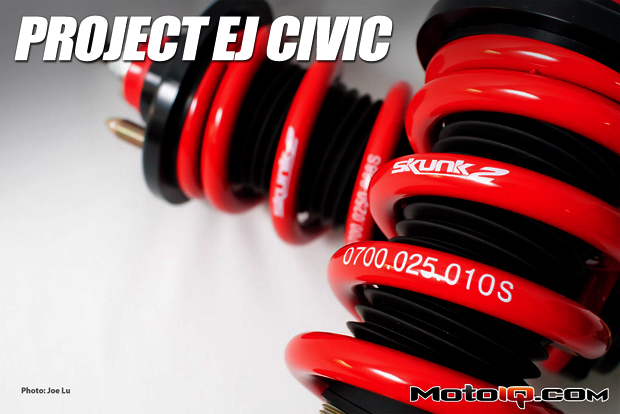,
Though there were many available shock designs for the Civic, we were particularly drawn to the Skunk2 Pro-C coilovers monotube design. Monotube dampers contain a piston and rod within a single tube, with the compression and rebound valving all within that one piston. Monotubes have some advantages over the more common twin tube shocks. Twin tube designs are often found on cheaper shocks like the stock shocks on most cars. Although there are excellent twin tube shocks out there, generally monotubes have more advantages for a performance shock.
One of the benefits of the Pro-C monotube designs in comparison to the cheaper (not high quality performance twin tubes) twin tubes is that the large 45mm piston in the bigger diameter monotube displaces more oil, which creates more flow through the valves. This can make the monotube more sensitive to small suspension movement at low shaft speeds. Low speed control is the most critical for handling as body roll, dive and squat occurs in the region of low shaft speeds. Also, the higher flow can make for more consistent and accurate damping force.
The Pro-C shock controls damping by having the fluid flow through some orifices in the piston that are covered by super thin stacked stainless steel washers. When fluid flows through the orifices when the piston moves, the washers must deflect to allow fluid flow. This type of valving is called a deflected disk design and the washer stack is called a christmas tree. The diameter, thickness and the stack up of different diameter and thickness washers and the number and size of the piston orifices controls the shape of the damping curve and the amount of damping force. Altering the christmas tree is how you adjust the basic damping characteristics of the shocks. There is one christmas tree on one side of the piston for compression and another on the opposite side for rebound. The christmas trees turns the piston into two different one way valves with ultra precise metering. Deflected disk valves are pretty sensitive and do a good job when set up correctly.
The main piston is machined from stainless steel. This is much better than the net shape cast aluminum or even zinc used typically in lower priced shocks. A machined piston can control tolerances to less than 0.001″ which is at least 5 times tighter than those of a cast piston. Controlling tolerances in the piston makes for much tighter tolerance in damping force, by making the amount of blowby consistent. A typical OEM tolerance for instance is plus or minus 10% of the total damping force. This is one of the reasons why all high end motorsports dampers use machined pistons. Piston failure of cheap cast pistons is also common in extreme use and the use of stainless steel will just about make this impossible,
A floating piston at the bottom of the damper provides a physical barrier between the dampers oil and the compressible high-pressure nitrogen gas needed for shaft displacement. Monotube dampers usually run at higher internal pressures in the 300-psi range. The higher pressure greatly reduces bubble creating cavitation of the oil as it travels through the valves. With most twin tubes the gas can mix with the oil resulting in inconsistent damping.
A disadvantage of many monotubes, the seal on the floating separator piston is a single low quality O-ring which tends to leak. Failure of the gas separator piston seal is what caused Dai Yoshihara to spin while driving the Team MotoIQ Sentra in the last MPTCC race. Skunk2 has addressed that problem as well. The Pro-C’s have a triple seal with twin O-rings and a lip seal for their piston as you can see in the above diagram. Since monotubes have a higher internal working pressure, a good quality shaft seal is also important. The Pro-C also has a triple lip main shaft seal as well.
More benefits? These monotube shocks can run cooler than a low end twin tube due to a lack of outer tube and a layer of insulating gas that blocks internally generated heat. So when someone tries to tell you that twin tube shocks are always better than monotube, you can tell them that it’s not always the case!






